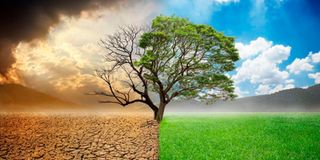What shall we eat when the rains fail?

Climate change has already happened, its ramifications are here and the urgency is real.
Last year, we lost our crop because the rains came. Meru County has four agro-ecological zones. The so-called cotton zone, where we farm, receives between 350mm and 500mm of rain a year, split into two seasons, the big one in October which is suitable for cereals, particularly maize, and a brief season in March during which the legumes, beans mainly, do well.
As they have always done, the farmers planted maize in October and beans towards the end of the season. The rains were unseasonably heavy and they got a bumper maize harvest and almost no beans.
During the short rains, they planted lots of beans and almost no maize. The rains were heavy and therefore the beans harvest was poor.
This is the story of peasant African agriculture, which employs large parts of labour and on which food security is dependent. The farm system is almost antediluvian, access to farm technology and capital is poor and even access to forecasting and climate change information is almost non-existent.
Mt Kenya, Africa’s tallest mountain, is on course to lose its glaciers in about six years. Lewis glacier, its biggest, has shrunk 90 per cent since the 1930s.
If the glaciers are gone, the two million people who rely on that ecosystem for water and sustenance will be devastated – a lot faster than everyone anticipates.
Africa is agriculture-dependent; 72 per cent of Uganda’s labour is employed on farms. Disruptions to agriculture have far-reaching social and economic consequences. In the first quarter of 2023, Kenya’s food import bill shot up 54 per cent to Sh80 billion, compared to last year.
The country was spending 92 per cent of its export earnings importing rice, maize and other foods. That means the forex resources for the huge debt servicing and inputs such as fuel were constrained.
Africa is warming faster than the global average and will be between two and four degrees hotter by 2100. If the increase is four degrees, then the continent will be hit by changes in rainfall with the wet areas getting wetter – a 30 per cent increase in rainfall – and the drier areas will get 20 per cent less rainfall.
According to ILRI, 118 million extremely poor Africans will be exposed to more severe droughts and floods.
Africa will have a population of 2.5 billion by 2050 and will only be able to meet 13 per cent of their food needs. The 240 million who are already malnourished will increase by between 25 per cent and 95 per cent depending on region.
Southern Africa will see the biggest increase, followed by West Africa. In three decades, Africa could become a land of the starving.
Steady progress
Quite apart from the collapse of food security, climate change could easily reverse the gains made in development. Uganda cut poverty levels from 56 per cent in 1992, to 21 per cent in 2016 and did so by making great strides in sectors such as coffee.
Uganda has made steady progress to become Africa’s second largest exporter of coffee, accounting for 17 per cent of its forex earnings, according to the World Bank.
However, climate change stands to undo this progress. Recent droughts have destroyed half of the yield and without mitigation, Uganda will only be able to produce coffee on a paltry one per cent of the land under coffee.
On the agenda at the Africa Climate Summit hosted jointly by the African Union and the government in Nairobi, is a discussion on sustainable agriculture, land, water and ocean use. Africa has a long way to go to make its agriculture climate-smart.
The widespread and poorly regulated application of fertilisers and chemicals has ruined soils. Old methods of animal and crop care as well as inadequate storage technology means that African agriculture is already in trouble.
The continental will need to climb out of a deep hole and build resilience and adaptation at the same time.
Poverty makes communities vulnerable. “No adaptation strategy can be successful without ensuring high vulnerability populations have the financial, technical and institutional resources they need to adapt,” says the World Bank in The Adaptation Principles: 6 Ways to Build Resilience to Climate Change. How do governments which already have budgetary problems provide these resources? Refining carbon markets and encouraging agri-forestry even on smallholder lots might be one way.
Secondly, adaption is at the individual, community or company and help must be directed at them to make the necessary changes in farm practices and attitudes towards sustainable use of resources. And critical community infrastructure, such as weather services, requires investment. As often pointed out, closing windows ahead of a hurricane can reduce damage to the house by 50 per cent. Climate change has already happened, its ramifications are here and the urgency is real.
Some African countries are making progress in agriculture. They are moving beyond merely working to ensure that their people have permanent access to enough food, but they are asserting their right as nations to grow whatever they want their own way. But countries working in isolation will not go as far and move as quickly as the continent in concert.
Africa brings to the table massive resources: 60 per cent of the world’s remaining fallow arable land, 30 to 40 per cent of the world’s minerals and massive renewable energy potential. The African moment is here, in many ways, is here. If only we can eat when the rains come, we can start figuring out what we shall eat, when the rains fail.





